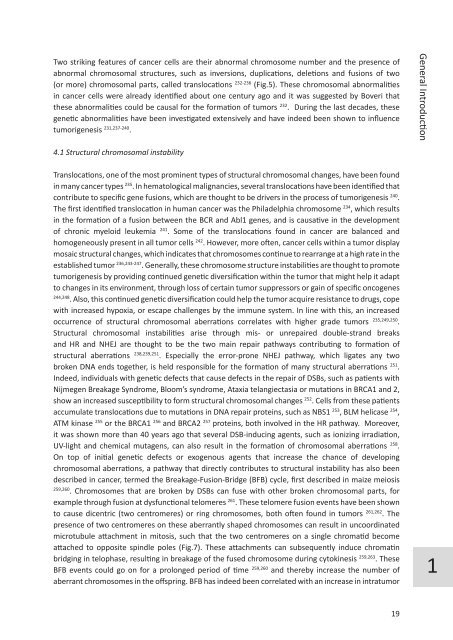Chromosome segregation errors: a double-edged sword - TI Pharma
Chromosome segregation errors: a double-edged sword - TI Pharma
Chromosome segregation errors: a double-edged sword - TI Pharma
You also want an ePaper? Increase the reach of your titles
YUMPU automatically turns print PDFs into web optimized ePapers that Google loves.
Two striking features of cancer cells are their abnormal chromosome number and the presence of<br />
abnormal chromosomal structures, such as inversions, duplications, deletions and fusions of two<br />
(or more) chromosomal parts, called translocations 232-236 (Fig.5). These chromosomal abnormalities<br />
in cancer cells were already identified about one century ago and it was suggested by Boveri that<br />
these abnormalities could be causal for the formation of tumors 232 . During the last decades, these<br />
genetic abnormalities have been investigated extensively and have indeed been shown to influence<br />
tumorigenesis 231,237-240 .<br />
4.1 Structural chromosomal instability<br />
Translocations, one of the most prominent types of structural chromosomal changes, have been found<br />
in many cancer types 235 . In hematological malignancies, several translocations have been identified that<br />
contribute to specific gene fusions, which are thought to be drivers in the process of tumorigenesis 240 .<br />
The first identified translocation in human cancer was the Philadelphia chromosome 234 , which results<br />
in the formation of a fusion between the BCR and Abl1 genes, and is causative in the development<br />
of chronic myeloid leukemia 241 . Some of the translocations found in cancer are balanced and<br />
homogeneously present in all tumor cells 242 . However, more often, cancer cells within a tumor display<br />
mosaic structural changes, which indicates that chromosomes continue to rearrange at a high rate in the<br />
established tumor 236,243-247 . Generally, these chromosome structure instabilities are thought to promote<br />
tumorigenesis by providing continued genetic diversification within the tumor that might help it adapt<br />
to changes in its environment, through loss of certain tumor suppressors or gain of specific oncogenes<br />
244,248 . Also, this continued genetic diversification could help the tumor acquire resistance to drugs, cope<br />
with increased hypoxia, or escape challenges by the immune system. In line with this, an increased<br />
occurrence of structural chromosomal aberrations correlates with higher grade tumors 235,249,250 .<br />
Structural chromosomal instabilities arise through mis- or unrepaired <strong>double</strong>-strand breaks<br />
and HR and NHEJ are thought to be the two main repair pathways contributing to formation of<br />
structural aberrations 238,239,251 . Especially the error-prone NHEJ pathway, which ligates any two<br />
broken DNA ends together, is held responsible for the formation of many structural aberrations 251 .<br />
Indeed, individuals with genetic defects that cause defects in the repair of DSBs, such as patients with<br />
Nijmegen Breakage Syndrome, Bloom’s syndrome, Ataxia telangiectasia or mutations in BRCA1 and 2,<br />
show an increased susceptibility to form structural chromosomal changes 252 . Cells from these patients<br />
accumulate translocations due to mutations in DNA repair proteins, such as NBS1 253 , BLM helicase 254 ,<br />
ATM kinase 255 or the BRCA1 256 and BRCA2 257 proteins, both involved in the HR pathway. Moreover,<br />
it was shown more than 40 years ago that several DSB-inducing agents, such as ionizing irradiation,<br />
UV-light and chemical mutagens, can also result in the formation of chromosomal aberrations 258 .<br />
On top of initial genetic defects or exogenous agents that increase the chance of developing<br />
chromosomal aberrations, a pathway that directly contributes to structural instability has also been<br />
described in cancer, termed the Breakage-Fusion-Bridge (BFB) cycle, first described in maize meiosis<br />
259,260 . <strong>Chromosome</strong>s that are broken by DSBs can fuse with other broken chromosomal parts, for<br />
example through fusion at dysfunctional telomeres 261 . These telomere fusion events have been shown<br />
to cause dicentric (two centromeres) or ring chromosomes, both often found in tumors 261,262 . The<br />
presence of two centromeres on these aberrantly shaped chromosomes can result in uncoordinated<br />
microtubule attachment in mitosis, such that the two centromeres on a single chromatid become<br />
attached to opposite spindle poles (Fig.7). These attachments can subsequently induce chromatin<br />
bridging in telophase, resulting in breakage of the fused chromosome during cytokinesis 259,263 . These<br />
BFB events could go on for a prolonged period of time 259,260 and thereby increase the number of<br />
aberrant chromosomes in the offspring. BFB has indeed been correlated with an increase in intratumor<br />
19<br />
General Introduction 1













